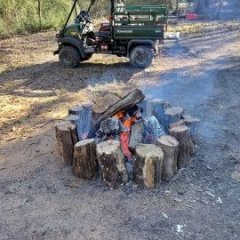-
Posts
829 -
Joined
-
Last visited
-
Days Won
153
Content Type
Profiles
Events
Forums
Gallery
Downloads
Community Map
Everything posted by kenfain
-

engine oil cooler 2003 kawasaki 550 mule
kenfain replied to Glen Burrows's topic in Kawasaki UTV SxS Forum
That sounds like it might be a good idea on an air cooled engine. But I don't know if that would work. If you could fit one of those kits that relocate the oil filter. That might give better flow. I'd carefully document the engine temperature before doing anything. That way you'll know how well it works. -
Essex manufacturing used to sell tires that were made just for them. They had Kevlar in the tread, and were made special for the utv. The selection was pretty limited, but they were nice looking tires. It'd be worth a look.
- 1 reply
-
- 1
-

-
Operating a winch under load should always be done with the engine running. Those things draw an outrageous amount of amps when under a heavy load. I learned that lesson the hard way. As to the battery issue, I'd check the alternator output, vs. amp load. If you're using a lot of amps on accessories, winch, lights etc. you might want to upgrade that alternator.
-
Mine is an 05 diesel. The only light that lights up before starting is the oil pressure light. Of course yours could be different. I think they went to some kind of onboard computer system soon after mine was built, but I don't know when. So yours could be a completely different machine.
-
5.5 and some change according to google.
-
I use a powered speaker made by ION, it rides on the roof, secured by bungee cords. It's big, and it's not pretty, but it's extremely loud, and lasts for hours. Portable, self contained, with no power drain on the vehicle.
-
Now THAT is funny. But you know you're buying experience. Sometimes it pays off directly, sometimes it's down the road. Troubleshooting is where you REALLY need to pay attention.
-
The comment about extra parts is just to say that the whole engine works together, as a system. If the engine doesn't have the compression it's supposed to have, or lacks a robust performance. It would be easy to say " If only I'd honed that cylinder I could be certain that it isn't some kind of blowby issue. Unless you're a seasoned mechanic, it's ALL gremlins, and voodoo. Especially when you're talking about something like honing. My advice is to hone that sumbitch, and move on. I told you from the beginning, that you'll have to go back into the motor....It happens...almost always. It's how we learn, so embrace it lol. When you get it right...it'll be worth it.
-
I would concur with all that's been mentioned above, but to also add, honing is also used to get rid of metal transfer residue. This happens with aluminum pistons. Usually it's a big problem for chainsaws, and such. Never heard of it being a problem on bigger engines. So honing in your case is probably optional. It's definitely recommended, but I wouldn't think there'd be much difference. If the motor is still out of the chassis, I'd take it apart, because I know myself too well. My OCD wouldn't let me just forget about it. As far as which hone to get, the one with the stones give a nice cross hatch pattern, which is what most people want. I didn't look at any of the others that you linked. But most of the rest will polish the cylinder. Polishing a cylinder is useful for 2 cycle engines, but certainly won't hurt yours. After all, that's what the rings are going to start doing immediately after starting it up. My recommendation would be to get the machine shop up the street to do that as well. Since a cylinder hone is not something you'll ever use much, why buy one? Honing used to be dirt cheap, probably still is. This will also allow you to ask these guys any questions that you might still have. Disassembling, and assembly will go much quicker,and be much easier this time around. It'll also give you a chance to check your previous work. I'd say to just wade on in. Think of it this way; if you don't, and you can't seem to get it running right. You'll start second guessing all the stuff that you missed, or skipped. Since a motor doesn't have any extra parts, or needless rebuild procedures. Even something as simple as skipping the honing, will become suspect. I can almost guarantee that it won't be the problem, but this way it'll be eliminated for certain.
-
Glad you got it sorted out!
-
Welcome to the forum, I hope this works out for you. Let us know how it goes. Good luck!
-
This sounds like an aftermarket lift. The factory lift is hydraulic IIRC. If it is electric, then it probably has a worm screw driven mechanism. If this is an aftermarket lift, try giving it a helping hand by pulling up on it while operating the lift switch. You might need some help with the lifting up of the bed. Sometimes the worm screw just needs some help getting to some good threads. Of course the bed should be empty when you do this. If this is the problem, you'll be able to hear it turning. And if that's the case, and this fix doesn't work, you'll have to pull the bed hinge pins, raise the lift, and replace the pins. Do this while it's raised. If this works, then you'll always want to keep the bed up about a half inch from the bed rails. That way it'll always be in the good threads. The fix gets easier after you've done it a couple of times. Hope this makes sense.
-
Just like a typical car.
-
Parts might not be hard to find, but they wouldn't be cheap. I doubt there'd be much of a used parts market. Unfortunately the news gets worse from there. The specifications aren't very impressive, and they're underpowered. Unless you just want 4wd, I'd buy a used golf cart. Add tires and a lift kit.
-

A Stubborn Mule: Mule 2500, electrical and other questions
kenfain replied to John Mason's topic in Kawasaki UTV SxS Forum
Any luck finding information about that mule? -

A Stubborn Mule: Mule 2500, electrical and other questions
kenfain replied to John Mason's topic in Kawasaki UTV SxS Forum
Well, it doesn't look anything at all like mine, but I'll try to help, all I can. First off the dash looks like it's been stripped of possibly an hour meter, on the right side. If it's wired like mine, then it would plug into the two single pin, black wires, shown in the picture above, just to the right of the six pin connector. Of course that's just a guess. And possibly an oil pressure warning light. I would expect both of those items to be on the dash. The six pin block on mine is for adding accessories, like lights. I'll check my owners manual for vin location, since I don't remember. Edit; what I've found is this page from the owners manual, which shows where the frame number, and engine numbers are located. If the picture is unclear, it's indicating the frame, underneath the seat. What I've been unable to find, is the model number plate, which also shows the year. IIRC this plate is located underneath the vehicle, and towards the very front. But it's been about thirteen years since I've laid eyes on mine, so I could be wrong. As to the dash instrument issue, mine has a parking brake indicator, and water temp light combination, in the area that in your picture, clearly shows something has been removed. Edit; after more closely looking at your dash picture. My opinion would be that the empty spot on the right, would have been used for the 4wd lever in a 4wd vehicle. They would've likely used the same dash panel. I'm basing this guess on the shape of the slotted holes. It's very similar to the other side with the diff lock lever. -
Yes, I can understand how some mechanics can inflate a problem. But I'm just pointing out that the proper diagnosis is everything. Just replacing suspect parts will only lead to frustration. I've been there before. You can certainly follow a gut feeling, and replace what you think the problem is. Leaking valve guides seems reasonable, considering the symptoms. You might get lucky. In answer to the time it takes to change out the valve seals. It should be about three hours or so. That's assuming he's pulling the head, to change them. Some people have used air pressure to hold the valve in place while changing out those seals. I've also heard of stuffing rope down in through the spark plug hole to accomplish this. It's a less invasive approach, and saves money on parts.
-
I wouldn't jump to a conclusion about the valve seals being the problem. Obviously they are a prime suspect, but if you're going to let a mechanic fix it...then let a qualified mechanic diagnose it also. When you tell a mechanic that you need new seals, then that's what you'll get. Even if that's not the problem. What if it's a cracked ring? Or a head gasket? Have you pulled the plugs, and checked each one?
-
Welcome to the forum!! I would think a garmin would be what you want. The kind that does rural, not one of those that does only roads.
-
OBD2 is the same as what is used on all cars and light trucks manufactured for sale in America since 1996. If it has the same plug, it likely takes the same reader. The professional versions of these readers can cost more than a thousand dollars. When software for these professional readers is added ( and they're updated often, since each manufacturer has brand specific codes) the cost can be several thousand dollars. But the good news is, there's generic information in each system, that's common to all vehicles that use the system. So you don't need the expensive version of this tool. You can use the cheap one, (they're about a hundred bucks) and do a little detective work. The code reader will tell you which part, or system needs to be investigated further. However in your case even that might not be necessary. But unfortunately, it will require someone who either knows, or has access to specific voltage values for that particular models electrical components. This information would still be necessary, even if you had the code reader. That's not saying that a reader wouldn't help. But you still need to be able to decipher the gibberish that a code reader puts out. On a car, there's lots of information on the internet that helps you decipher the information. On one of these, there just isn't that much that can be wrong with it, since there just aren't many components there. And I doubt that even the internet would help with diagnosis. I suspect that a multimeter and some time spent checking the components involved in telling the fuel system how much fuel it needs to start would be the best course of action.
-
Is this thing OBD2, or something else? If it is, OBD2, there's fairly cheap options out there for live data readers.
-
Since there couldn't be much to it, taking that measurement. I would think, that they wouldn't mind measuring that for you. Since you've had them do some other work on this same engine. I'd suggest that you take it with you, and visit the shop. Talk to the guy that you talked to before, about the casting defect/crack. And ask how you'd go about measuring for that shim. Tell him what you don't understand about the procedure. Or that you don't have the tool, whatever. Maybe offer him ten bucks. My guess would be that you'd just use a feeler gauge. Making sure that the crank is pulled forward, if it has any play, front to rear. But I've never dealt with that, and without seeing it in person, I can only guess.
-
Over torqued bolts can stretch. The next step is to break. When they break, they're nearly impossible to extract. I doubt that You'll have any trouble, but it's your call. I personally, wouldn't worry about it. But I'd be very careful when tightening.
-
Depending on what you want to do with it, the 3000 lb. winch is probably what you want. For getting a stuck 1200 pound vehicle out of the mud, a 3000 lb. winch is a minimum. But that doesn't mean it'll always be enough to do the job in a worst case scenario. Even with a snatch block, there could be a time there's simply not enough power. For logs, it should be enough, especially when used with a snatch block, or 2. I find a winch to be a lot of trouble to actually use, and I typically use a come along more often. The winch cable is a pain to get it retracted properly. If it's not done right it'll foul it up in the winding, making it tough to deploy next time. Or worse, it'll damage the cable. You'll want to switch to that soft winch rope as soon as possible, you'll like it better. My recommendation is to buy a harbor freight model, or similar, since you won't use it much. Get one with a wireless remote, but make sure there's a wired controller too. Wireless is very handy, but dead batteries can ruin your day. Use a winch cover. Winching is very dangerous, so read up on proper techniques. ALWAYS leave the motor running! These things can draw a battery down in seconds, at full power. Remember, the nearest object to anchor to will always be just out of reach when you're stuck. So take a few extra recovery straps. FWIW, I've got the Warn 3000lb. on mine, and it's about the same size machine. Hope this helps! Good luck
-
I've driven many different brands of vehicles. The cheaper brands, just feel cheap. That's just my opinion. I'd recommend buying a nice used vehicle, rather than a cheap new one. You have to be honest about what its intended use is for. These can be very specialized machines. For example, a mud buggy, won't be very good at hauling wood. It'll work, but not well. Bigger is better on these things. There's nothing wrong with the small ones, but the bigger ones hold more stuff. So unless you're wanting mud specific, or putting it in the back of a pickup...get a full size machine. Probably most important of all, is parts availability. Buying a recognized brand will be the best for this. If I were buying a used machine, I'd look at a Polaris, or Kubota, for the bigger ones. Especially the Kubota diesel. And I'm definitely not a fan of computer controlled units. So older just makes sense to me.








